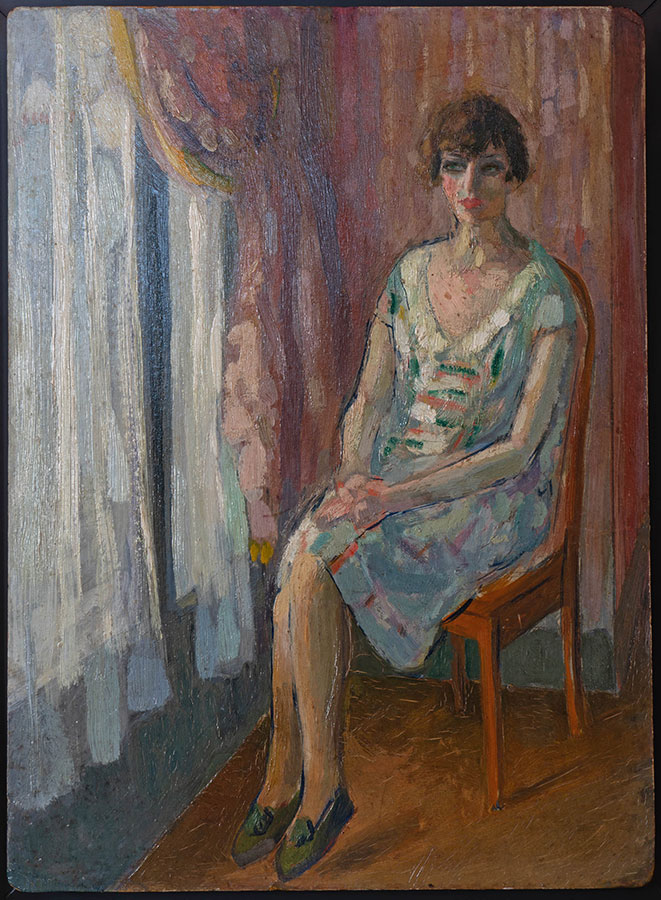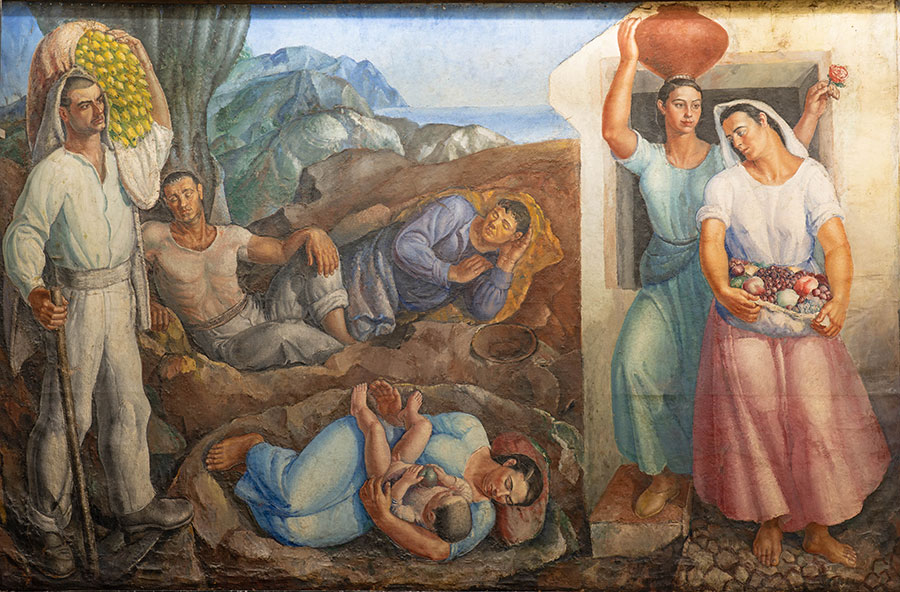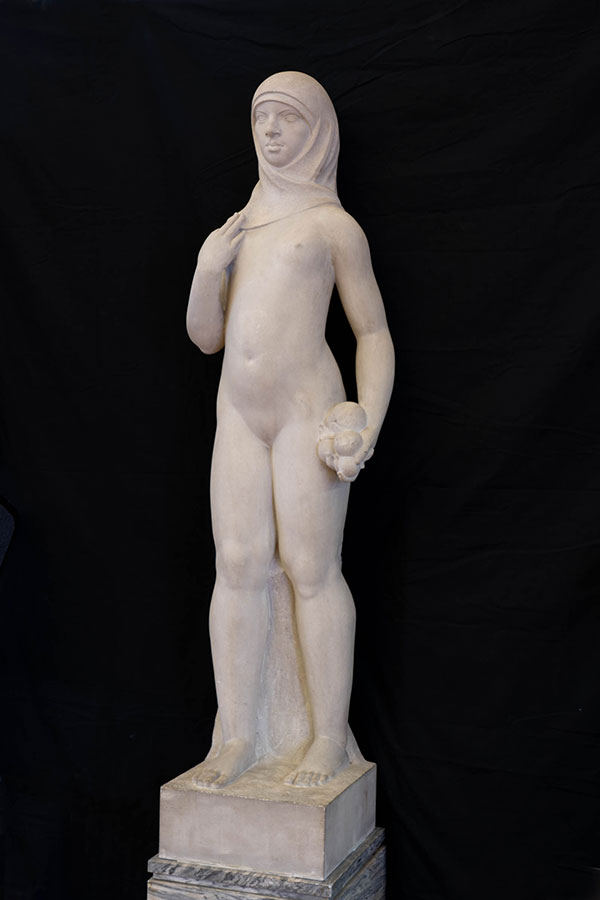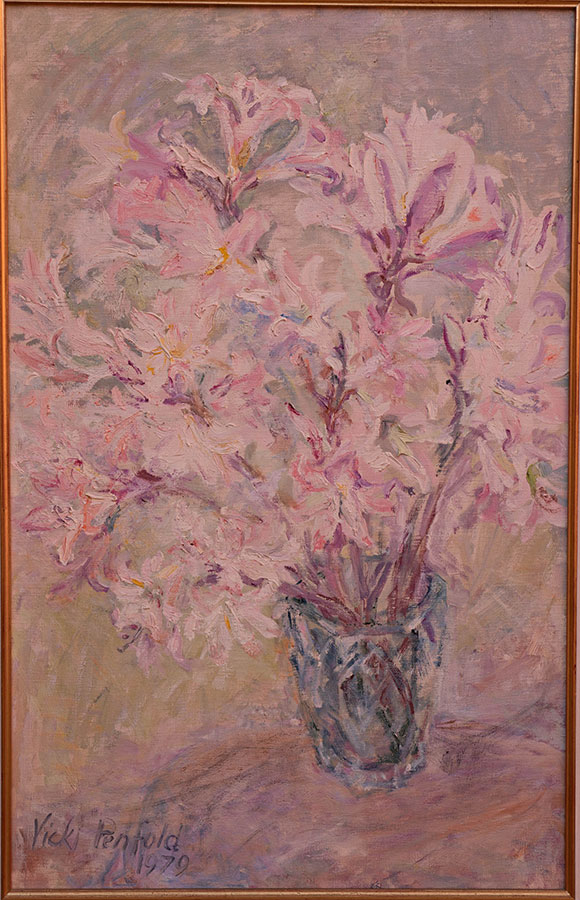
- Type of work: Easel painting
- Technique: Oil on cardboard
- Approximate dimensions: 33 x 24 cm
- Subject: Portrait
- Title: Portrait of the painter’s wife
- Author: Álvaro Fariña Álvarez (1897-1972)
- Chronology or Year: C. 1930
- Historical-artistic analysis:
Style: Within post-impressionism, close to expressionist language with Fauvist technique.
Description: This is a full-length portrait of a young woman, seated in a chair slightly turned to the left, inside a room, next to a large window. With a structural sense in the orderly and restrained organization of the composition, in the synthetic vision of the representation, with a certain prominence of the line in terms of the delimitation of objects, the great chromatic sense stands out, since color is the fundamental basis in the construction of this painting. The use of broad brushstrokes, flat colors, spots that overlap as in the Fauvist technique in a great chromatic harmony, recreate the scene in warm tones, with a concern for light in the white fabrics of the curtain or dress, where touches of mauve, gray or blue are added to this tonality, with great freedom.
Date of receipt: Acquired by the Casino in July 2007.
Observations: This is the portrait of the artist’s wife, Antonia Domínguez Palazón, whose features appear perfectly represented, especially the deep look in her black eyes. The casual posture, with legs crossed, speaks of the break with previous conventions and the representation of women in a freer and more modern posture, in accordance with the Parisian moment of the twenties, the decade to which the portraits of his wife belong, specifically between 1926 and 1929. The work of that period was shown in the solo exhibition held at the Alexandre Lefranc hall in Paris in 1927, where he presented 30 pieces, and at the Círculo de Bellas Artes in Santa Cruz de Tenerife the following year.
About the authorÁlvaro Fariña Álvarez (Tacoronte 1897 – 1972) manifested his artistic vocation when he attended high school in La Laguna, where he had José Aguiar and Pedro de Guezala as classmates, and at the same time his love for music was born. During his training period at L’Escola d’Art d’en Galí and of Arts and Crafts in Barcelona, continued at the Escuela Superior de Bellas Artes de San Fernando in Madrid (1016 to 1922), he also studied music, first violin at the Liceo Filarmónico Dramático and later guitar in Madrid with Daniel Fortea. Three periods can be established in his production: the training period with the influence of Nonell’s expressionism and Catalan noucentisme, with a taste for the sinuous and decorative line, in addition to the Fauvist technique in terms of chromatic treatment, to which is added the academic teaching during his stay in Madrid, influenced by Romero de Torres and his links with the avant-garde intellectual scene, since he stayed at the Residencia de Estudiantes and frequented the gatherings of the Café Pombo. A second period in Paris (1926-29), where he lived with his wife after their marriage in December 1925. Here he paints outdoors, landscapes and streets of the Montmatre district, as well as portraits in the studio, with a technique close to Fauvism in which color is the constructive element of the composition. A solo exhibition at the Alexandre Lefranc Gallery allowed him to show this work in Paris in July 1927, which he also exhibited at the Círculo de Bellas Artes in Santa Cruz de Tenerife in 1930, the year he returned to the island. In the third stage (from 1929 to 1972) he practically abandons painting except for some sporadic works, dedicating himself fundamentally to teaching (first at the Círculo de Bellas Artes, at his home, at the Instituto de segunda enseñanza de Almería during the civil war and from 1952 at the Escuela de Artes y Oficios and at the Escuela de Bellas Artes de Santa Cruz de Tenerife). He participates in some group exhibitions always with old works, except for some novelties such as the Portrait of Alberto Brito or the Landscape of Tacoronte of the Exhibition of the Association of Canary Watercolorists of 1962. The group Nuestro Arte organizes an anthological exhibition in the Municipal Museum of Fine Arts of Santa Cruz de Tenerife in 1964, anthological exhibitions also organized by the Círculo de Bellas Artes (1983), the Centro Cultural CajaCanarias (1988) and the Viceconsejería de Cultura y Deportes del Gobierno de Canarias (La Regenta, 1989), after his death in April 1972.
Bibliography:
Archive of the Casino de Tenerife
Consuelo CONDE MARTEL: Fariña. Vice-Ministry of Culture and Sports, Government of the Canary Islands. Santa Cruz de Tenerife, 1991.



